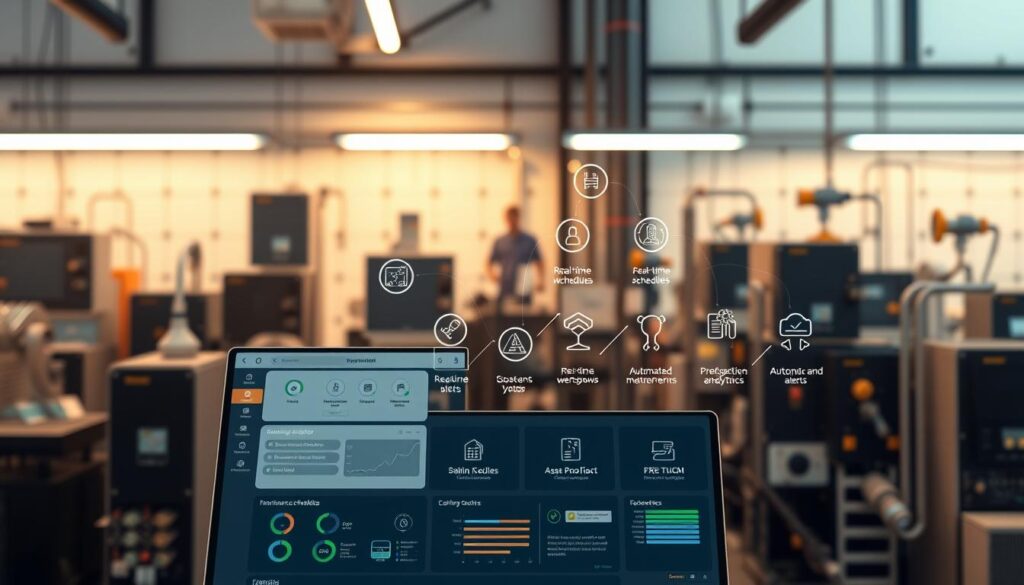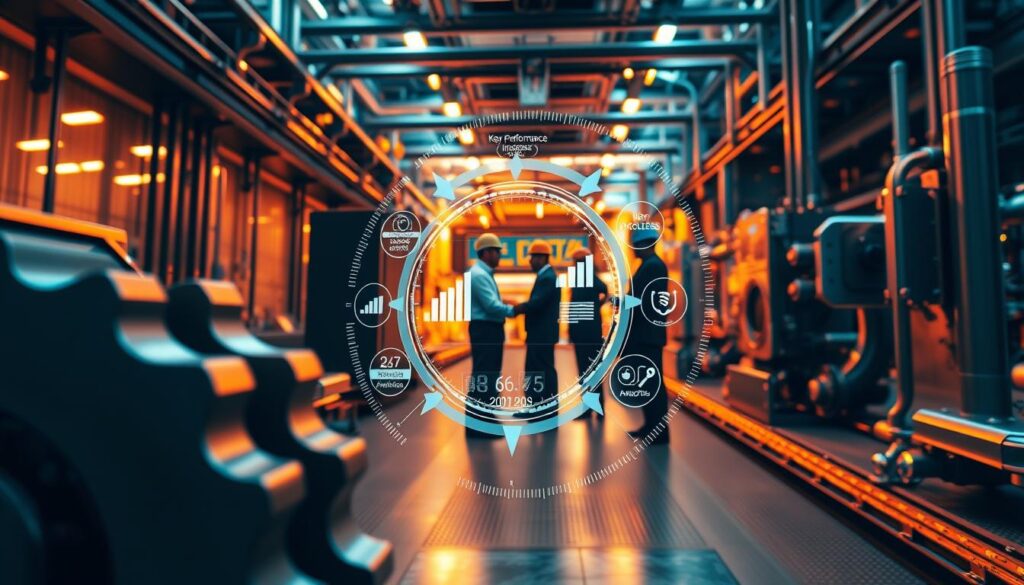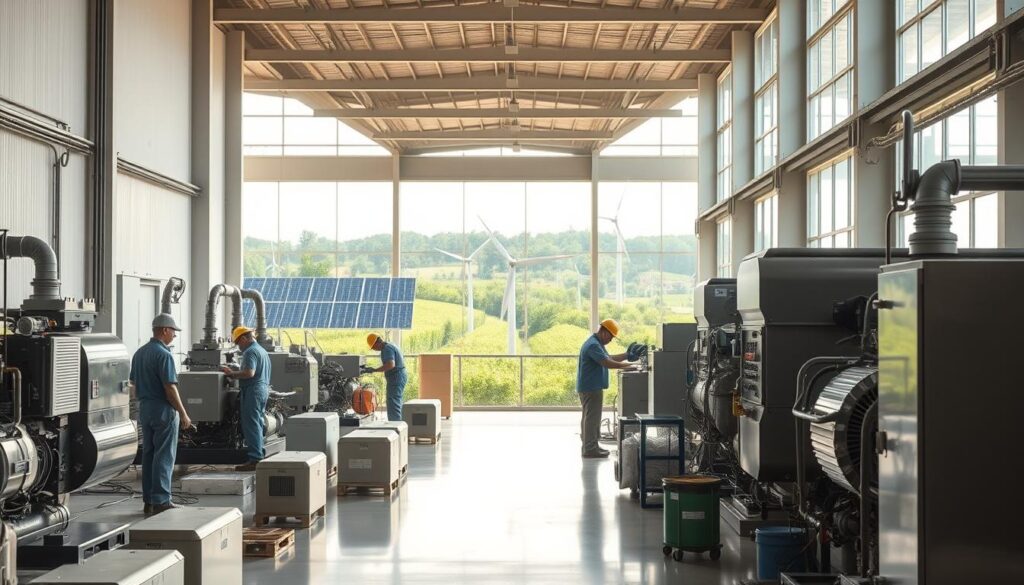Effective maintenance planning is crucial for reducing costs over the lifecycle of equipment. By adopting a long-term mindset, businesses can optimize their strategies and achieve significant savings.
Understanding the costs associated with equipment is key to making informed decisions. A well-planned maintenance schedule can help prevent costly breakdowns and extend the lifespan of machinery.
Key Takeaways
- Effective maintenance reduces lifecycle costs.
- Adopting a long-term mindset optimizes maintenance strategies.
- Maintenance planning is crucial for cost savings.
- Understanding equipment costs informs maintenance decisions.
- Preventive maintenance prevents costly breakdowns.
Understanding Maintenance and Lifecycle Costs
The key to achieving long-term cost savings lies in comprehending maintenance costs and the lifecycle cost concept. Effective maintenance is not just about fixing things when they break; it’s about understanding the total cost of ownership and implementing a lifecycle management strategy that optimizes expenses over the lifespan of an asset.
What are Maintenance Costs?
Maintenance costs encompass expenses related to the upkeep, repairs, and replacement of equipment. These costs can be significant and vary widely depending on the type of asset, its age, and how well it is maintained. As David Simchi-Levi, a renowned expert in supply chain management, once noted, “Maintenance is a critical component of operational excellence.” Understanding these costs is the first step in cost optimization.
Maintenance costs can be categorized into several types, including preventive maintenance, corrective maintenance, and predictive maintenance. Each type has its own set of costs and benefits. For instance, preventive maintenance can reduce the likelihood of equipment failure, thereby reducing corrective maintenance costs in the long run.
The Lifecycle Cost Concept
The lifecycle cost concept considers all costs associated with an asset throughout its lifespan, from acquisition to disposal. This includes initial purchase or installation costs, operating costs, maintenance costs, and eventual disposal or recycling costs. By considering the total cost of ownership, businesses can make more informed decisions about their assets. As highlighted in a guide on cutting construction costs in Africa, understanding lifecycle costs can lead to significant savings.
“The total cost of ownership is a critical metric that helps organizations understand the true cost of their assets.”
Implementing a lifecycle management strategy involves analyzing these costs and identifying opportunities for cost savings. It requires a long-term perspective and a thorough understanding of the asset’s lifecycle. By doing so, businesses can achieve significant cost savings and improve their overall operational efficiency.
Importance of Long-term Thinking in Maintenance

Embracing long-term thinking in maintenance practices allows organizations to proactively address potential issues, thereby minimizing downtime and maximizing productivity. By adopting a proactive maintenance approach, businesses can anticipate and prevent costly repairs, reduce unplanned downtime, and optimize equipment performance.
A key aspect of long-term thinking in maintenance is asset lifecycle planning. This involves understanding the entire lifecycle of equipment, from installation to disposal, and planning maintenance activities accordingly. Effective asset lifecycle planning enables businesses to make informed decisions about when to perform maintenance, replace equipment, or upgrade facilities.
Why Long-term Thinking Matters
Long-term thinking in maintenance matters because it allows businesses to move beyond reactive maintenance practices, which can be costly and inefficient. By focusing on long-term maintenance strategies, organizations can improve equipment reliability, reduce maintenance costs over time, and enhance overall operational efficiency.
The benefits of long-term thinking in maintenance include:
- Reduced maintenance costs through proactive planning
- Improved equipment reliability and performance
- Enhanced operational efficiency and productivity
- Better decision-making through data-driven maintenance strategies
Shifting from Short-term to Long-term Focus
Shifting from a short-term to a long-term focus in maintenance requires a change in mindset and the adoption of proactive maintenance strategies. It involves moving away from reactive maintenance practices, which focus on immediate fixes, towards a more strategic approach that considers the long-term implications of maintenance decisions.
Maintenance strategy development is critical in this shift. It involves analyzing maintenance needs, identifying opportunities for improvement, and developing strategies that align with the organization’s long-term goals. By doing so, businesses can ensure that their maintenance practices support their overall objectives and contribute to long-term success.
Key Components of Lifecycle Costs
Effective maintenance planning hinges on comprehending the various components that constitute lifecycle costs. Lifecycle costs are a comprehensive measure of the total expense associated with owning and maintaining equipment or assets over their entire lifespan.
Initial Investment and Setup
The initial investment includes the purchase price of the equipment, installation costs, and any initial setup or commissioning expenses. This upfront cost is a significant component of lifecycle costs and can have a lasting impact on the overall expense.
Operating Costs Over Time
Operating costs encompass the expenses incurred during the operational phase, including energy consumption, maintenance and repair costs, and any consumables or supplies required for operation. These costs can vary over time and are influenced by factors such as equipment efficiency and maintenance quality.
Key factors influencing operating costs include:
- Energy efficiency
- Maintenance frequency and quality
- Operator training and proficiency
Disposal and Replacement Costs
At the end of an asset’s life, businesses must consider the costs associated with disposal or replacement. This includes decommissioning costs, disposal fees, and the cost of acquiring new equipment. Understanding these costs is crucial for long-term planning and budgeting.
By breaking down lifecycle costs into these key components, businesses can identify areas for cost optimization and develop targeted strategies to minimize their total cost of ownership. This approach enables more effective maintenance planning and contributes to achieving long-term cost savings.
The Impact of Poor Maintenance

Failing to implement a proactive maintenance approach can have detrimental effects on equipment lifespan and overall business profitability. When maintenance is neglected, the consequences can be far-reaching, impacting not just the immediate operational efficiency but also long-term financial health.
Hidden Costs of Neglect
Poor maintenance can lead to a myriad of hidden costs, including reduced equipment efficiency, increased energy consumption, and premature wear. These costs are often not immediately apparent but can significantly affect the bottom line over time. For instance, a piece of equipment that is not properly maintained may require more energy to operate, leading to increased utility bills.
Key areas affected by poor maintenance include:
- Increased repair costs due to neglected upkeep
- Downtime resulting from equipment failure
- Reduced productivity due to inefficient systems
Long-term Efficiency Losses
Neglecting maintenance can result in significant long-term efficiency losses. Over time, equipment that is not properly maintained will deteriorate, leading to decreased performance and potentially catastrophic failures. This not only affects operational efficiency but also leads to costly repairs or even replacement.
| Maintenance Aspect | Short-term Impact | Long-term Impact |
|---|---|---|
| Equipment Efficiency | Minor reductions in performance | Significant decrease in efficiency |
| Energy Consumption | Moderate increase in energy use | Substantial rise in energy costs |
| Repair Costs | Occasional repair needs | Frequent and costly repairs |
By adopting a proactive maintenance approach, businesses can mitigate these risks, ensuring that their equipment operates at optimal levels, thereby minimizing lifecycle costs and enhancing overall profitability.
Cost-effective Maintenance Strategies
A well-planned maintenance strategy can significantly lower maintenance costs. By adopting the right approaches, businesses can reduce operational expenses and improve equipment reliability.
Preventive Maintenance Approaches
Preventive maintenance involves regular upkeep to prevent equipment failures. This approach includes routine inspections, cleaning, and replacement of parts before they fail. By doing so, businesses can avoid costly downtime and extend the lifespan of their equipment. For more information on preventive maintenance strategies, visit Western Specialty Contractors.
Benefits of Preventive Maintenance:
- Reduced equipment downtime
- Lower repair costs
- Improved equipment efficiency
Predictive Maintenance Techniques
Predictive maintenance uses data and analytics to anticipate maintenance needs. By leveraging technologies such as IoT sensors and data analytics, businesses can predict when equipment is likely to fail and schedule maintenance accordingly. This approach helps in optimizing maintenance schedules and reducing unnecessary maintenance activities.
Key aspects of Predictive Maintenance include:
- Real-time monitoring of equipment conditions
- Data-driven maintenance scheduling
- Reduced maintenance costs through optimized scheduling
By combining preventive and predictive maintenance approaches, businesses can develop a comprehensive maintenance strategy that enhances cost optimization and improves overall equipment reliability.
Benefits of a Maintenance Management System

By adopting a maintenance management system, companies can significantly enhance their operational efficiency. This is achieved through the automation of maintenance tasks, improved work order management, and data-driven decision-making.
Streamlining Operations
A maintenance management system helps in streamlining operations by organizing maintenance activities, scheduling tasks, and tracking work orders. This leads to reduced downtime and increased productivity.
Some key features that contribute to streamlined operations include:
- Automated scheduling of maintenance tasks
- Efficient work order management
- Real-time tracking of maintenance activities
For more information on how maintenance management software can benefit your organization, visit WhipAround.
Enhanced Decision-Making
With a maintenance management system, businesses can make informed decisions based on data analysis. This includes insights into equipment performance, maintenance history, and resource allocation.
The following table highlights the benefits of using a maintenance management system for enhanced decision-making:
| Feature | Benefit |
|---|---|
| Data Analytics | Provides insights into equipment performance and maintenance needs |
| Maintenance History | Helps in identifying recurring issues and planning proactive maintenance |
| Resource Allocation | Optimizes the allocation of resources for maintenance activities |
In conclusion, a maintenance management system is essential for businesses aiming to improve their maintenance practices. By streamlining operations and enhancing decision-making, companies can achieve significant cost savings and optimize equipment performance.
Creating a Maintenance Schedule
A well-structured maintenance schedule is the backbone of any effective maintenance strategy. It ensures that maintenance tasks are performed in a timely and efficient manner, reducing downtime and improving overall equipment reliability.
Frequency and Timing Considerations
When creating a maintenance schedule, it’s essential to consider the frequency and timing of maintenance tasks. This involves understanding the equipment’s usage patterns, manufacturer recommendations, and regulatory requirements. For instance, equipment that operates in harsh environments may require more frequent maintenance. Developing an effective preventive maintenance schedule can help organizations avoid costly repairs and reduce downtime.
Timing is also critical, as maintenance tasks should be performed during periods of low usage or when the equipment is not critical to production. This helps minimize disruptions and ensures that maintenance personnel have the necessary resources and access to the equipment.
Balancing Cost and Performance
Balancing cost and performance is a delicate task when creating a maintenance schedule. Organizations must weigh the costs of maintenance against the benefits of improved equipment reliability and performance. This involves considering factors such as the cost of replacement parts, labor costs, and the potential costs of downtime.
Cost-effective maintenance strategies can be achieved by implementing a predictive maintenance approach, which uses data and analytics to predict when maintenance is required. This approach can help reduce maintenance costs by minimizing unnecessary tasks and ensuring that maintenance is performed only when necessary.
By developing a well-planned maintenance schedule, organizations can optimize their maintenance practices, reduce costs, and improve equipment reliability. This, in turn, can lead to improved productivity, reduced downtime, and increased overall efficiency.
Measuring ROI on Maintenance Investments

Evaluating the return on investment (ROI) for maintenance activities is crucial for businesses aiming to optimize their lifecycle costs. By understanding the financial benefits of their maintenance strategies, companies can make informed decisions that impact their bottom line.
Tools for Calculation
Several tools are available to help businesses calculate the ROI on their maintenance investments. These include ROI analysis software, financial modeling tools, and maintenance management systems (MMS) that track and analyze maintenance data.
Using these tools, organizations can quantify the cost savings achieved through effective maintenance practices. For instance, a company might use ROI analysis to compare the costs of different maintenance strategies, such as preventive versus corrective maintenance.
Understanding Payback Periods
The payback period is another critical metric for evaluating maintenance investments. It represents the time required for the investment to generate returns equal to its initial cost.
Understanding payback periods helps businesses prioritize maintenance projects based on their potential to deliver quick returns. A shorter payback period generally indicates a more attractive investment opportunity.
| Maintenance Strategy | Initial Cost | Annual Savings | Payback Period |
|---|---|---|---|
| Preventive Maintenance | $100,000 | $25,000 | 4 years |
| Predictive Maintenance | $150,000 | $30,000 | 5 years |
By carefully evaluating ROI and payback periods, businesses can optimize their maintenance investments, reduce their total cost of ownership, and improve overall cost optimization.
Training and Staff Development
A well-trained maintenance team is vital for ensuring the reliability and efficiency of equipment. Effective maintenance is not just about the technology and equipment; it’s also about the personnel who manage and maintain them.
Importance of Skilled Personnel
Skilled personnel are the backbone of any successful maintenance operation. They are responsible for implementing a proactive maintenance approach that can significantly reduce downtime and improve overall equipment effectiveness. By investing in staff training, businesses can enhance their maintenance capabilities, leading to better decision-making and more efficient operations.
Investing in Continuous Education
Continuous education is crucial in the ever-evolving field of maintenance. As new technologies emerge, maintenance staff must be equipped to handle them effectively. Investing in continuous education ensures that staff are up-to-date with the latest best practices in asset lifecycle planning and maintenance techniques. This not only improves maintenance outcomes but also contributes to the overall maintenance strategy development.
By prioritizing training and staff development, organizations can reap significant benefits, including improved equipment reliability, reduced maintenance costs, and enhanced operational efficiency.
Case Studies Highlighting Long-term Savings

The adoption of a lifecycle management strategy has enabled companies to optimize their maintenance costs, leading to considerable long-term savings. This approach involves considering all costs associated with a product or system throughout its entire lifecycle, from initial investment to disposal.
Successful Maintenance Models
Several industry leaders have implemented successful maintenance models that have resulted in significant reductions in maintenance costs. For instance, a leading manufacturing company adopted a predictive maintenance approach, utilizing advanced sensors and data analytics to predict equipment failures. This proactive strategy allowed the company to reduce unplanned downtime by 30% and lower maintenance costs by 25% over a period of two years.
Another example is a transportation company that implemented a cost optimization program focused on regular maintenance scheduling and crew training. As a result, they achieved a 20% reduction in maintenance costs and a 15% decrease in fuel consumption over three years.
| Industry | Maintenance Strategy | Cost Savings |
|---|---|---|
| Manufacturing | Predictive Maintenance | 25% |
| Transportation | Regular Scheduling and Crew Training | 20% |
Lessons Learned from Industry Leaders
Industry leaders have shared valuable insights into effective maintenance practices through various case studies. A key takeaway is the importance of adopting a proactive maintenance approach, such as lifecycle costing, to anticipate and prevent equipment failures.
Moreover, companies have emphasized the need for continuous training and development of maintenance personnel to ensure they are equipped with the latest skills and knowledge. This not only enhances the effectiveness of maintenance activities but also contributes to long-term cost savings.
Leveraging Technology for Maintenance Efficiency
Leveraging technology is key to optimizing maintenance operations, reducing costs, and improving overall performance. The integration of advanced technologies such as the Internet of Things (IoT) and data analytics is transforming maintenance practices, enabling real-time monitoring and predictive maintenance.
Role of IoT in Maintenance
The IoT plays a significant role in modern maintenance by connecting devices and equipment, allowing for real-time data collection and analysis. This connectivity enables maintenance teams to monitor equipment health remotely, predict potential failures, and schedule maintenance accordingly. According to a study on leveraging predictive maintenance, the use of IoT can significantly reduce unplanned downtime and extend the lifespan of equipment.
By utilizing IoT devices, organizations can implement a proactive maintenance approach, reducing the likelihood of unexpected equipment failures and the associated costs. This proactive strategy is a crucial component of an effective maintenance management system.
Utilizing Data Analytics
Data analytics is another critical technology in enhancing maintenance efficiency. By analyzing data collected from equipment and IoT devices, maintenance teams can gain valuable insights into equipment performance and potential issues. This data-driven approach enables organizations to make informed decisions regarding maintenance scheduling, resource allocation, and asset lifecycle planning.
Moreover, data analytics can help identify trends and patterns that may not be apparent through other means, allowing for more effective maintenance strategies. As noted in discussions on how AI is transforming civil engineering, the application of data analytics and AI can lead to significant improvements in maintenance and overall project management.
By combining IoT and data analytics, organizations can achieve a more efficient and cost-effective maintenance operation, ultimately leading to improved productivity and reduced costs.
Sustainability and Maintenance

The intersection of maintenance and sustainability is where businesses can find significant opportunities for cost savings and environmental stewardship. As companies strive to reduce their environmental footprint, maintenance practices play a crucial role in achieving these goals.
Eco-friendly Practices
Adopting eco-friendly maintenance practices not only contributes to environmental sustainability but can also lead to cost optimization through reduced waste and energy consumption. Simple measures such as using eco-friendly cleaning products, optimizing energy usage in facilities, and implementing recycling programs for waste materials can make a significant difference.
Moreover, preventive maintenance can help in identifying potential issues before they become major problems, thereby reducing the likelihood of environmental hazards. For instance, regular checks on equipment can prevent leaks or spills that could harm the environment.
Regulatory Considerations
Besides the environmental benefits, adopting sustainable maintenance practices is also driven by regulatory requirements. Companies must comply with various environmental regulations and standards related to maintenance activities. Failure to comply can result in significant fines and damage to the company’s reputation.
Environmental sustainability is not just a moral imperative; it’s also a legal and financial one. By integrating sustainable practices into their maintenance routines, businesses can ensure they are meeting regulatory demands while also reducing their lifecycle costs.
To achieve this, companies should stay informed about the latest environmental regulations and standards. This includes understanding the implications of these regulations on their maintenance activities and making necessary adjustments to comply.
Customizing Maintenance Plans for Different Industries
Industries vary significantly in their maintenance needs, requiring bespoke strategies. Effective maintenance strategy development is crucial for ensuring that equipment and assets are properly maintained, thereby minimizing downtime and optimizing performance.
Different sectors have unique operational demands and challenges. For instance, the manufacturing sector relies heavily on machinery and equipment, making asset lifecycle planning a critical component of their maintenance strategy. A well-planned maintenance schedule can help prevent equipment failures, reduce production halts, and maintain product quality.
Manufacturing Sector Needs
The manufacturing industry requires maintenance plans that focus on minimizing downtime and maximizing productivity. This involves regular inspections, timely repairs, and replacement of parts. Implementing a preventive maintenance plan can significantly reduce the likelihood of unexpected equipment failures.
Service Industry Maintenance Challenges
In contrast, the service industry faces different maintenance challenges, primarily related to equipment reliability and customer satisfaction. For example, in the hospitality sector, maintaining facilities and equipment is crucial for ensuring guest comfort and safety. This requires a maintenance strategy that prioritizes reliability and responsiveness.
By understanding the specific maintenance needs of their industry, businesses can develop industry-specific maintenance plans that address their unique challenges. This tailored approach not only enhances operational efficiency but also contributes to long-term cost savings.
Creating a Culture of Maintenance Awareness

A well-informed workforce is the backbone of effective maintenance strategy development. By fostering a culture that prioritizes maintenance, businesses can improve their maintenance practices and achieve significant cost savings. This cultural shift involves more than just implementing new procedures; it requires engaging employees and stakeholders at all levels.
Engaging employees is a critical component of this cultural transformation. When employees understand the importance of maintenance and are equipped with the necessary skills and knowledge, they are more likely to contribute to a proactive maintenance approach. This not only enhances the overall efficiency of maintenance operations but also promotes a sense of ownership among employees.
Engaging Employees
To effectively engage employees, businesses should focus on providing comprehensive training programs that cover the latest maintenance techniques and technologies. This can include:
- Regular workshops and seminars
- On-the-job training sessions
- Access to online resources and tutorials
By investing in employee engagement, companies can ensure that their workforce is capable of implementing and maintaining effective maintenance strategies.
Communication Strategies
Effective communication is another vital aspect of creating a culture of maintenance awareness. Clear and consistent communication helps to ensure that all stakeholders are informed and aligned with the maintenance goals. This can be achieved through:
- Regular maintenance updates and reports
- Clear documentation of maintenance procedures
- Open channels for feedback and suggestions
By adopting these strategies, businesses can promote a collaborative environment where maintenance is everyone’s responsibility.
In conclusion, creating a culture of maintenance awareness is a multifaceted process that requires careful planning, employee engagement, and effective communication. By prioritizing these elements, businesses can develop a proactive maintenance approach that drives long-term cost savings and enhances overall operational efficiency.
Conclusion: Embracing Long-term Thinking
Embracing long-term thinking in maintenance is crucial for achieving sustainable cost savings. By adopting a lifecycle management strategy, businesses can reduce their maintenance costs and improve equipment reliability.
A lifecycle management strategy involves understanding the total cost of ownership, from initial investment to disposal. This approach enables businesses to prioritize cost optimization and make informed decisions about maintenance.
Path to Sustainable Savings
By focusing on long-term thinking about maintenance and lifecycle costs, organizations can create a culture of maintenance awareness. This culture shift encourages employees to prioritize maintenance, leading to improved equipment reliability and reduced downtime.
Future of Maintenance Practices
As businesses continue to adopt lifecycle management strategies, they will be better equipped to optimize their maintenance practices. This, in turn, will drive cost savings and improve overall efficiency. Effective cost optimization will be key to achieving these benefits.
